Decarbonization Pathways in EU Manufacturing: A Principal Component and Cluster Analysis
Abstract
1. Introduction
2. Literature Review
2.1. European Policies and Governance
2.2. Industrial Clusters and Shared Infrastructures
2.3. Supply Chains and Digitalization
2.4. Socio-Institutional and Methodological Dimensions
2.5. Research Hypotheses
3. Data and Methodology
3.1. Data and Variables
3.2. Methodology
3.2.1. Data Pre-Processing and Standardization
3.2.2. K-Means Clustering in the PCA Space
3.2.3. Robustness and Cross-Validation
4. Results
4.1. Descriptive Statistics and Stationarity
4.2. Correlation Analysis
4.3. Principal Component Analysis
4.4. Selection of the Number of Clusters and Internal Validation
5. Discussion
5.1. Latent Architecture and Identified Typologies
5.2. Comparative Typologies and Partial Convergence
5.3. Policy Implications and International Comparisons
5.4. Methodological Comparability and Lessons from Other Regions
6. Conclusions
6.1. Limitations
6.2. Future Research
Author Contributions
Funding
Data Availability Statement
Conflicts of Interest
Abbreviations
| AI | Artificial Intelligence |
| ARI | Adjusted Rand Index |
| BERD | Business Enterprise Research and Development |
| CBAM | Carbon Border Adjustment Mechanism |
| CCfD | Carbon Contracts for Difference |
| CCUS | Carbon Capture, Utilization, and Storage |
| EED | Energy Efficiency Directive |
| EIB | European Investment Bank |
| ETS | Emissions Trading System |
| EU ETS | European Union Emissions Trading System |
| GERD | Gross Domestic Expenditure on Research and Development |
| GVA | Gross Value Added |
| IEA | International Energy Agency |
| IoT | Internet of Things |
| LMDI | Logarithmic Mean Divisia Index |
| NZCSC | Net-Zero Carbon Supply Chains |
| O&G | Oil and Gas |
| PCA | Principal Component Analysis |
| PC1/PC2 | Principal Component 1/Principal Component 2 |
| RED | Renewable Energy Directive |
Appendix A
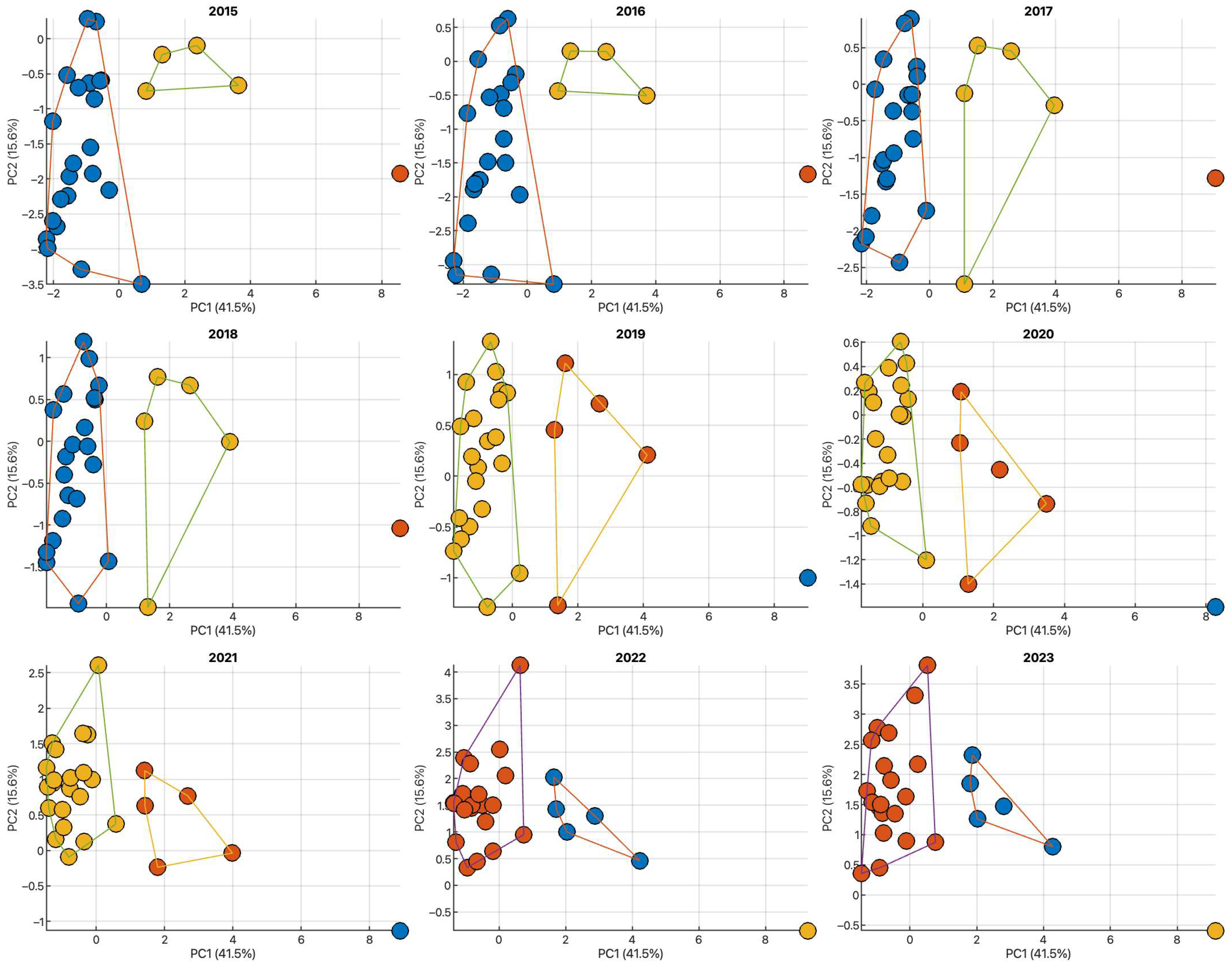
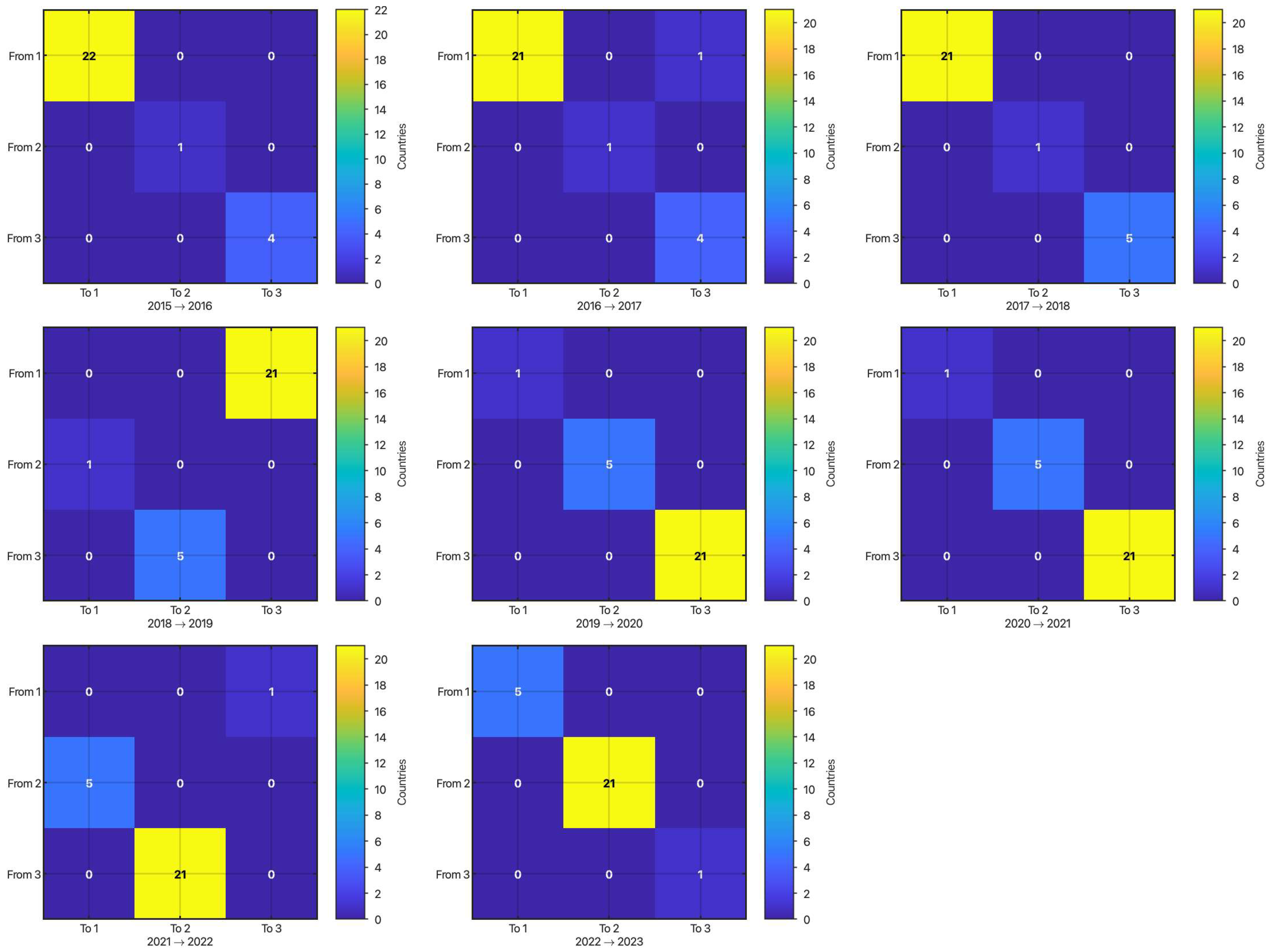
References
- International Energy Agency (IEA). Net Zero by 2050: A Roadmap for the Global Energy Sector; International Energy Agency: Paris, France, 2021; Available online: https://www.iea.org/reports/net-zero-by-2050 (accessed on 2 August 2025).
- International Energy Agency (IEA). Net Zero Roadmap: A Global Pathway to Keep the 1.5 °C Goal in Reach; International Energy Agency: Paris, France, 2023; Available online: https://www.iea.org/reports/net-zero-roadmap-a-global-pathway-to-keep-the-15-0c-goal-in-reach (accessed on 2 August 2025).
- European Commission. Fit for 55: Delivering the EU’s 2030 Climate Target on the Way to Climate Neutrality; Publications Office of the European Union: Luxembourg, 2023. Available online: https://op.europa.eu/en/publication-detail/-/publication/649643b0-9008-11ec-b4e4-01aa75ed71a1/language-en (accessed on 2 August 2025).
- European Parliamentary Research Service (EPRS). Fit for 55 Package—Briefing. PE 733.513; European Parliament: Brussels, Belgium, 2022. Available online: https://www.europarl.europa.eu/RegData/etudes/BRIE/2022/733513/EPRS_BRI(2022)733513_EN.pdf (accessed on 2 August 2025).
- Bataille, C.; Åhman, M.; Neuhoff, K.; Nilsson, L.J.; Fischedick, M.; Lechtenböhmer, S.; Solano-Rodriquez, B.; Denis-Ryan, A.; Stiebert, S.; Waisman, H.; et al. A review of technology and policy deep decarbonization pathway options for making energy-intensive industry production consistent with the Paris Agreement. J. Clean Prod. 2018, 187, 960–973. [Google Scholar] [CrossRef]
- Calvillo, C.; Race, J.; Chang, E.; Turner, K.; Katris, A. Characterisation of UK Industrial Clusters and Techno-Economic Cost Assessment for Carbon Dioxide Transport and Storage Implementation. Int. J. Greenh. Gas Control 2022, 119, 103695. [Google Scholar] [CrossRef]
- Reace, E.; Howe, J.; Font-Palma, C. Accelerating sustainability transitions: The case of the hydrogen agenda in the North West region of England. Sustain. Sci. Pract. Policy 2022, 18, 428–442. [Google Scholar] [CrossRef]
- Isoli, N.; Chaczykowski, M. Net energy analysis and net carbon benefits of CO2 capture and transport infrastructure for energy applications and industrial clusters. Appl. Energy 2025, 382, 125227. [Google Scholar] [CrossRef]
- Gunawan, T.A.; Luo, H.; Greig, C.; Larson, E. Shared CO2 capture, transport, and storage for decarbonizing industrial clusters. Appl. Energy 2024, 359, 122775. [Google Scholar] [CrossRef]
- Kryeziu, A.; Ursavas, E.; Varga, D.; Zhu, S.X. A practical assessment of CCUS opportunities in the Southeast European industrial sector—Bulgaria, Croatia, Greece, Romania. J. Clean. Prod. 2025, 517, 145723. [Google Scholar] [CrossRef]
- Rattle, I.; Gailani, A.; Taylor, P.G. Decarbonisation strategies in industry: Going beyond clusters. Sustain. Sci. 2024, 19, 105–123. [Google Scholar] [CrossRef]
- Sechi, S.; Giarola, S.; Leone, P. Taxonomy for industrial cluster decarbonization: An analysis for the Italian hard-to-abate industry. Energies 2022, 15, 8586. [Google Scholar] [CrossRef]
- Geels, F.W.; Sovacool, B.K.; Iskandarova, M. The socio-technical dynamics of net-zero industrial megaprojects: Outside-in and inside-out analyses of the Humber industrial cluster. Energy Res. Soc. Sci. 2023, 98, 103003. [Google Scholar] [CrossRef]
- Kyle, S.H.; Hall, J.K.; Sovacool, B.K.; Iskandarova, M. The industrial decarbonization paradigm: Carbon lock-in or path renewal in the United Kingdom? Ecol. Econ. 2025, 235, 108628. [Google Scholar] [CrossRef]
- Guo, X.; Huang, L.; Miao, H.; Mi, L.; Han, Z. Exploring carbon reduction pathways in the steel industry from the perspective of emerging technologies for achieving carbon neutrality. J. Environ. Manag. 2025, 385, 125768. [Google Scholar] [CrossRef]
- Gough, C.; Mander, S. CCS industrial clusters: Building a social license to operate. Int. J. Greenh. Gas Control 2022, 119, 103713. [Google Scholar] [CrossRef]
- Lai, H.-L.; Devine-Wright, P. Imagining and emplacing net zero industrial clusters: A critical analysis of stakeholder discourses. Geo-Geogr. Environ. 2024, 11, e00139. [Google Scholar] [CrossRef]
- Vagnini, C.; Vieira, L.C.; Longo, M.; Mura, M. Chasing net zero: An exploratory space-time analysis of European regions’ industrial carbon emissions. J. Environ. Manag. 2025, 391, 126466. [Google Scholar] [CrossRef]
- Mallett, A.; Kathuria, H.; Pal, P.; Thool, K.S. Pathways for the Indian steel sector: Realizing low carbon industrial clusters through a place-based approach in eastern India. Energy Res. Soc. Sci. 2025, 127, 104209. [Google Scholar] [CrossRef]
- Benedikt, B.; Münch, C.; Beckmann, M.; von der Gracht, H. Developing Net-Zero Carbon Supply Chains in the European Manufacturing Industry—A Multilevel Perspective. Supply Chain Manag. 2024, 29, 164–181. [Google Scholar] [CrossRef]
- Chen, Y.; Jiao, S.; Gu, X.; Li, S. Decoding the Spatiotemporal Effects of Industrial Clusters on Carbon Emissions in a Chinese River Basin. J. Clean. Prod. 2025, 516, 145851. [Google Scholar] [CrossRef]
- Oh, S.; Al-Juaied, M. Decarbonizing industrial hubs and clusters: Towards an integrated framework of green industrial policies. Energy Res. Soc. Sci. 2024, 118, 103777. [Google Scholar] [CrossRef]
- Rissman, J.; Bataille, C.; Masanet, E.; Aden, N.; Morrow III, W.R.; Zhou, N.; Elliott, N.; Dell, R.; Heeren, B.; Graus, W.; et al. Technologies and policies to decarbonize global industry: Review and assessment. Appl. Energy 2020, 266, 114848. [Google Scholar] [CrossRef]
- Cagno, E.; Accordini, D.; Thollander, P.; Andrei, M.; Monjurul Hasan, A.S.M.; Pessina, S.; Trianni, A. Energy management and Industry 4.0: Analysis of the enabling effects of digitalization on the implementation of energy management practices. Appl. Energy 2025, 390, 125877. [Google Scholar] [CrossRef]
- Yan, K.; Gao, H.; Liu, R.; Lyu, Y.; Wan, M.; Tian, J.; Chen, L. Review on low-carbon development in Chinese industrial parks driven by bioeconomy strategies. Renew. Sust. Energy Rev. 2024, 199, 114541. [Google Scholar] [CrossRef]
- Ngwaka, U.; Khalid, Y.; Ling-Chin, J.; Counsell, J.; Pinedo-Cuenca, R.; Dawood, H.; Smallbone, A.J.; Dawood, N.; Roskilly, A.P. Decarbonisation pathways for industrial clusters through multi-energy systems. Sustain. Futures 2025, 9, 100656. [Google Scholar] [CrossRef]
- Menéndez-Sánchez, J.; Fernández-Gómez, J.; Araujo-de-la-Mata, A. Sustainability Strategies by Oil and Gas Companies, Contribution to the SDGs and Local Innovation Ecosystems. Energies 2023, 16, 2552. [Google Scholar] [CrossRef]
- Liao, C.; Wang, S.; Zhang, Y.; Song, D.; Zhang, C. Driving forces and clustering analysis of provincial-level CO2 emissions from the power sector in China from 2005 to 2015. J. Clean. Prod. 2019, 240, 118026. [Google Scholar] [CrossRef]
- Shui, B.; Cai, Z.; Luo, X. Towards customized mitigation strategy in the transportation sector: An integrated analysis framework combining LMDI and hierarchical clustering method. Sust. Cities Soc. 2024, 107, 105340. [Google Scholar] [CrossRef]
- Turner, K.; Race, J.; Alabi, O.; Calvillo, C.; Katris, A.; Swales, K. Policy Trade-Offs in Introducing a CO2 Transport and Storage Industry to Service the UK’s Regional Manufacturing Clusters. Ecol. Econ. 2022, 201, 107547. [Google Scholar] [CrossRef]
- Calvillo, C.; Katris, A.; Race, J.; Corbett, H.; Turner, K. Regional employment implications of deploying CO2 transport and storage to decarbonise the UK’s industry clusters. Ecol. Econ. 2025, 233, 108587. [Google Scholar] [CrossRef]
- Devine-Wright, P. Decarbonisation of Industrial Clusters: A Place-Based Research Agenda. Energy Res. Soc. Sci. 2022, 91, 102725. [Google Scholar] [CrossRef]
- Ewers, M.; Brannstrom, C.; Conrecode, C. What are the emerging contours of regional decarbonization? Insights from an exploratory analysis of US clean hydrogen hubs. Geoforum 2025, 163, 104294. [Google Scholar] [CrossRef]
- Luo, J.; Huang, M.; Bai, Y. Visual Analysis of Low-Carbon Supply Chain: Development, Hot-Spots, and Trend Directions. Front. Environ. Sci. 2022, 10, 995018. [Google Scholar] [CrossRef]
- Ran, F.; Xu, X.; Yu, Z.-T.; Lin, Q. A Machine-Learning Assisted Multi-Cluster Assessment for Decarbonization in the Chemical Fiber Industry toward Net-Zero: A Case Study in a Chinese Province. J. Clean. Prod. 2023, 425, 138965. [Google Scholar] [CrossRef]
- Eurostat. Eurostat Database (Data Browser); Eurostat: Luxembourg, 2025. Available online: https://ec.europa.eu/eurostat (accessed on 2 August 2025).
- Hastie, T.; Tibshirani, R.; Friedman, J. The Elements of Statistical Learning: Data Mining, Inference, and Prediction, 2nd ed.; Springer: New York, NY, USA, 2009. [Google Scholar] [CrossRef]
- Gareth, J.; Witten, D.; Hastie, T.; Tibshirani, R. An Introduction to Statistical Learning: With Applications in R, 2nd ed.; Springer: New York, NY, USA, 2021. [Google Scholar] [CrossRef]
- Jolliffe, I.T. Principal Component Analysis, 2nd ed.; Springer: New York, NY, USA, 2002. [Google Scholar] [CrossRef]
- Jolliffe, I.T.; Cadima, J. Principal component analysis: A review and recent developments. Philos. Trans. R. Soc. 2016, 374, 20150202. [Google Scholar] [CrossRef]
- Jain, A.K. Data clustering: 50 years beyond K-means. Pattern Recognit. Lett. 2010, 31, 651–666. [Google Scholar] [CrossRef]
- Kaplan, P.O.; Boyd, G.; Browning, M.; Perl, K.; Supekar, S.; Victor, N.; Worrell, E. Is the Industrial Sector Hard to Decarbonize or Hard to Model? A Comparative Analysis of Industrial Modeling and Net Zero Carbon Dioxide Pathways. Energy Clim. Chang. 2025, 6, 100190. [Google Scholar] [CrossRef]
- Hincapie-Ossa, D.; Frey, N.; Gingerich, D.B. Assessing County-Level Vulnerability to the Energy Transition in the United States Using Machine Learning. Energy Res. Soc. Sci. 2023, 100, 103099. [Google Scholar] [CrossRef]
- Jahangiri, Z.; Miri, M.; Yi, K.M.; McPherson, M. Machine learning-based uncertainty analysis in power system planning: Insights and pathways for decarbonization. Energy Rep. 2024, 12, 942–954. [Google Scholar] [CrossRef]
- Rousseeuw, P.J. Silhouettes: A graphical aid to the interpretation and validation of cluster analysis. J. Comput. Appl. Math. 1987, 20, 53–65. [Google Scholar] [CrossRef]
- Ward, J.H., Jr. Hierarchical grouping to optimize an objective function. J. Am. Stat. Assoc. 1963, 58, 236–244. [Google Scholar] [CrossRef]
- Hubert, L.; Arabie, P. Comparing partitions. J. Classif. 1985, 2, 193–218. [Google Scholar] [CrossRef]
- Pesaran, M.H.; Ullah, A.; Yamagata, T. A bias-adjusted LM test of error cross-section independence. Econom. J. 2008, 11, 105–127. [Google Scholar] [CrossRef]
- Pesaran, M.H. General Diagnostic Tests for Cross Section Dependence in Panels; Cambridge Working Papers in Economics No. 0435, 864; Faculty of Economics, University of Cambridge: Cambridge, UK, 2004. [Google Scholar] [CrossRef]
- Pesaran, M.H. A simple panel unit root test in the presence of cross-section dependence. J. Appl. Econ. 2007, 22, 265–862312. [Google Scholar] [CrossRef]
- Pablo-Romero, M.P.; Sánchez-Braza, A.; Torreblanca, C. Implementing the Circular Economy in the European Union and Spain: Links to the Low-Carbon Transition. Energies 2024, 17, 5255. [Google Scholar] [CrossRef]
- Tautorat, P.; Iversen, J.; Schmidt, T.S.; Steffen, B. Real Options Analysis of Decarbonization Investments in the Chemical Industry. Appl. Energy 2025, 397, 126238. [Google Scholar] [CrossRef]
- Dong, X.; Yu, M. Green bond issuance and green innovation: Evidence from China’s energy industry. Int. Rev. Financ. Anal. 2024, 94, 103281. [Google Scholar] [CrossRef]
- Jakimów, M.; Samokhalov, V.; Baldassarre, B. Achieving European Union strategic autonomy: Circularity in critical raw materials value chains. Int. Aff. 2024, 100, 1735–1748. [Google Scholar] [CrossRef]
- Griffiths, S.; Sovacool, B.; Iskandarova, M.; Walnum, H.J. Bridging the Gap between Defossilization and Decarbonization to Achieve Net-Zero Industry. Environ. Res. Lett. 2025, 20. Available online: https://iopscience.iop.org/article/10.1088/1748-9326/adaed6/pdf (accessed on 5 August 2025). [CrossRef]
- Herman, K.S.; Sovacool, B.K.; Geels, F.W.; Iskandarova, M. Navigating reconfiguration and systems disruption: Decarbonization pathways for UK industrial clusters. Energy 2025, 328, 136464. [Google Scholar] [CrossRef]
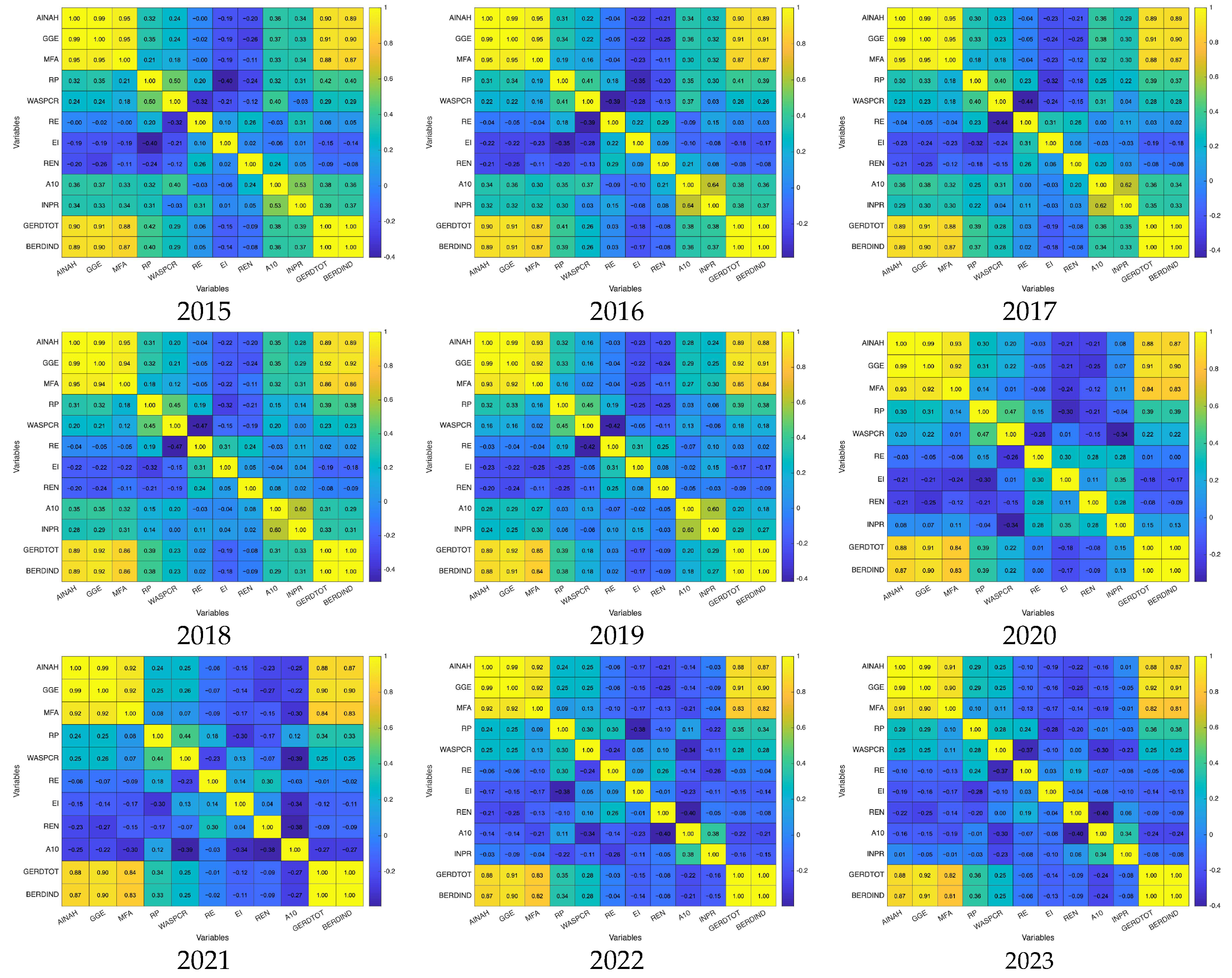
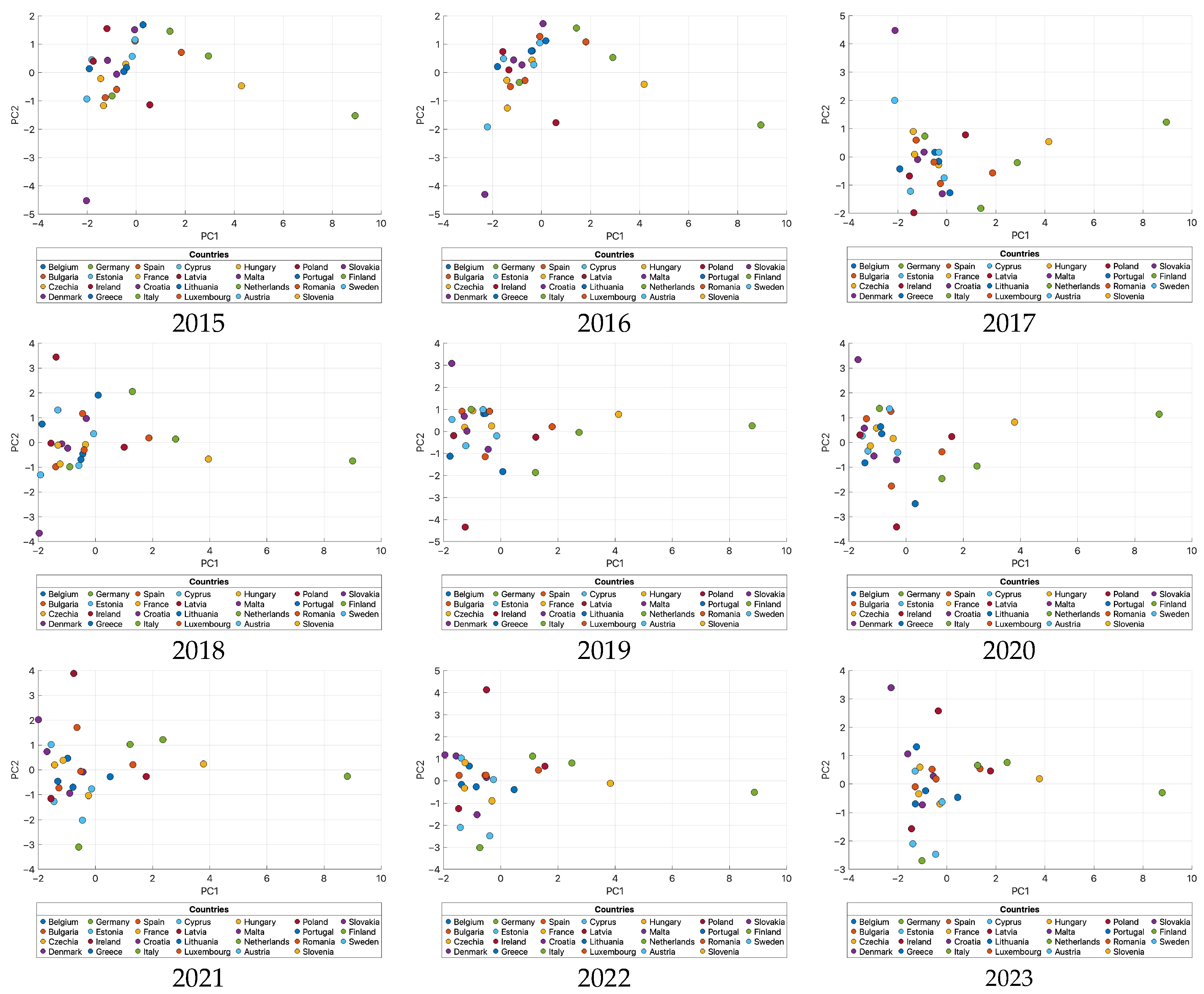
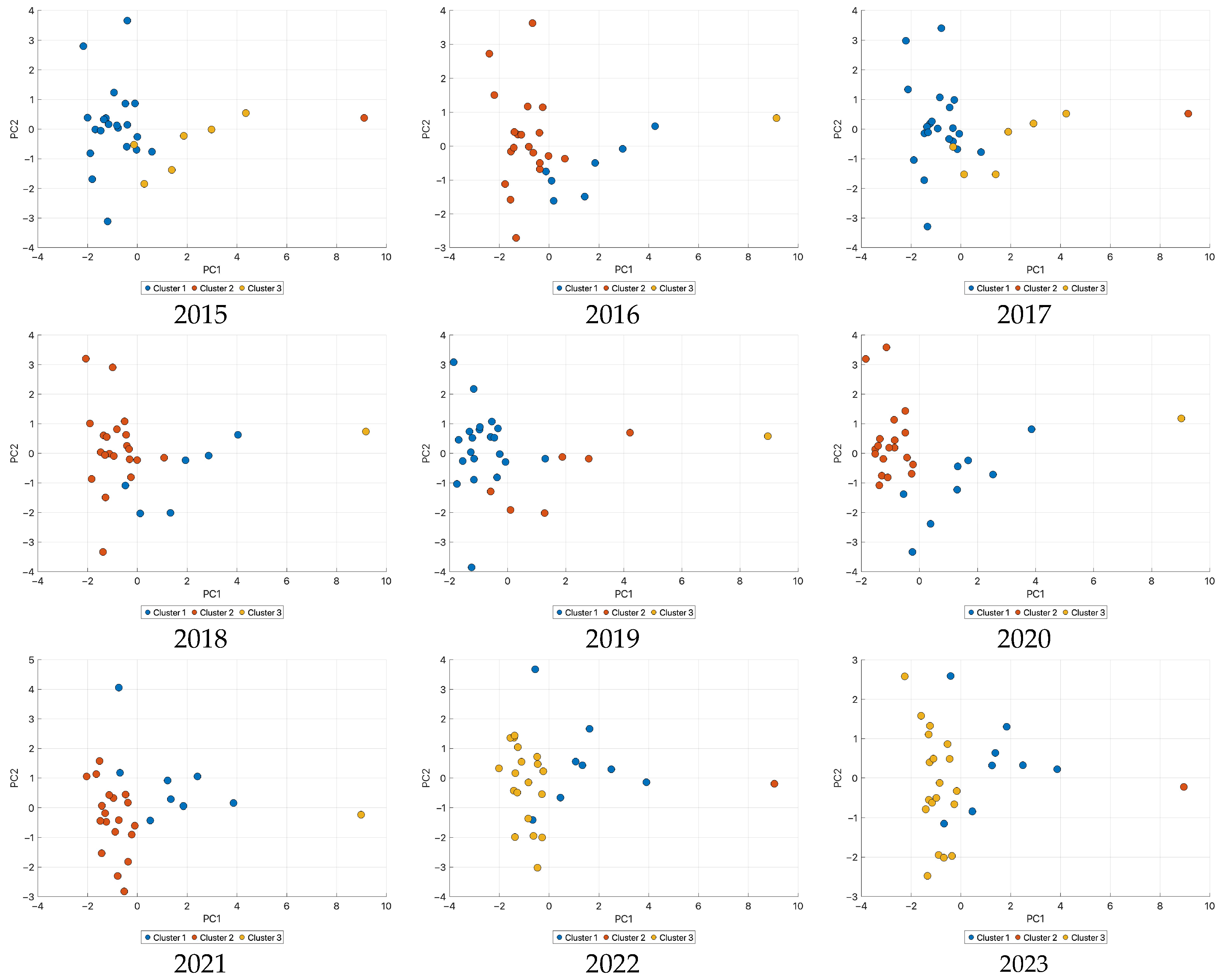

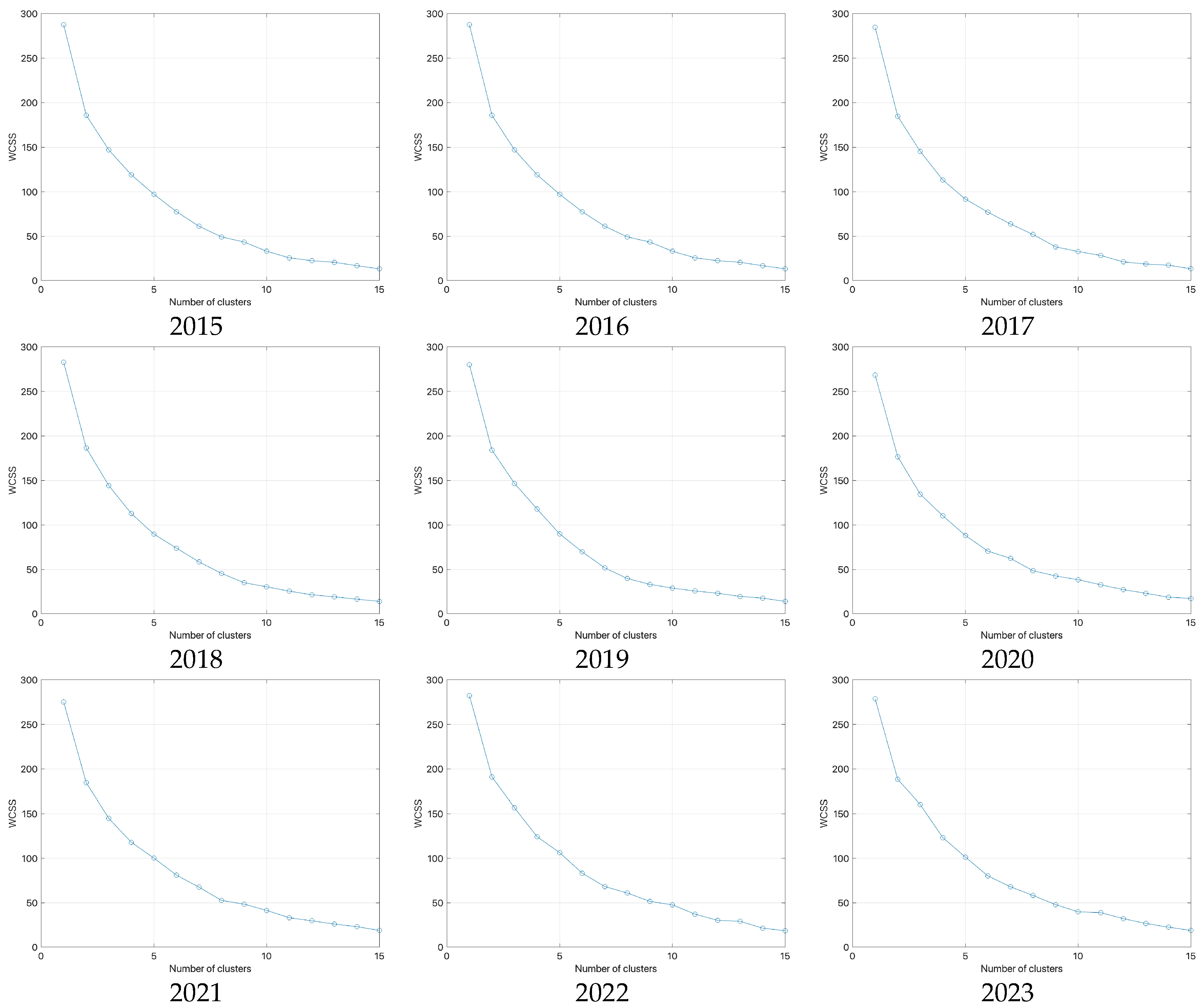

| Block | Dataset (Official Title) | SDMX Code | Units | Derived Indicator/Use |
|---|---|---|---|---|
| Environment | Air emissions accounts by NACE Rev.2 activity | env_ac_ainah_r2 (AINAH) | kilotonnes of CO2 equivalent | Emission intensity = GHG_C/GVA_C |
| Environment | Greenhouse gas emissions by source sector | env_air_gge (GGE) | kilotonnes of CO2 equivalent | Cross-check of emission levels at source |
| Environment | Material flow accounts | env_ac_mfa (MFA) | thousand tonnes | Resource context/ correlations |
| Environment | Resource productivity | env_ac_rp (RP) | EUR per kilogram | Resource efficiency context |
| Environment | Recycling rates of packaging waste | env_waspacr (WASPACR) | percent | Circularity context |
| Energy | Energy intensity in industry (indicator) | nrg_ind_ei (EI) | kilograms of oil equivalent per EUR | Official energy intensity (robustness check) |
| Energy | Share of energy from renewable sources (heating and cooling) | nrg_ind_ren (REN) | percent | Macro-level benchmark for RES (external validation) |
| Economy | Gross value added and income by main industry (NACE Rev.2) | nama_10_a10 (A10) | million EUR (volume) | GVA_C; Structure = GVA_C/GVA_total |
| Economy | Production in industry—annual data | sts_inpr_a (INPR) | index (2015 = 100) | Industrial cycle context /consistency checks |
| Innovation | GERD by sector of performance | rd_e_gerdtot (GERDTOT) | percent of GDP / thousand EUR | Technological capacity at firm level |
| Innovation | BERD by NACE Rev.2 activity | rd_e_berdindr2 (BERDIND) | thousand EUR | R&D intensity in C–Manufacturing |
| Variable | Mean | Maximum | Minimum | Std. Dev. | Skewness | Kurtosis | Jarque–Bera | Probability |
|---|---|---|---|---|---|---|---|---|
| AINAH | 8,779,392.0 | 66,600,000.0 | 1,345,031.0 | 12,300,000.0 | 2.7 | 10.7 | 920.0 | 0.000 |
| GGE | 120,281.1 | 936,055.3 | −2033.0 | 181,275.8 | 2.7 | 10.6 | 915.2 | 0.000 |
| MFA | 228,938.6 | 1,274,335.0 | 5329.2 | 270,792.1 | 2.0 | 7.0 | 340.5 | 0.000 |
| RP | 2.1 | 7.4 | 0.3 | 1.3 | 1.0 | 3.9 | 48.7 | 0.000 |
| WASPCR | 63.3 | 85.3 | 26.8 | 10.1 | −0.9 | 4.3 | 54.3 | 0.000 |
| RE | 34.3 | 69.8 | 16.3 | 10.5 | 1.5 | 5.6 | 168.2 | 0.000 |
| EI | 115.2 | 215.5 | 33.7 | 34.7 | 0.4 | 3.2 | 6.6 | 0.036 |
| REN | 24.9 | 77.4 | 5.0 | 15.1 | 1.5 | 5.2 | 146.9 | 0.000 |
| A10 | 102.3 | 126.7 | 74.2 | 8.5 | −0.2 | 4.2 | 16.9 | 0.000 |
| INPR | 95.4 | 122.4 | 59.1 | 9.5 | −1.1 | 4.9 | 90.8 | 0.000 |
| GERDTOT | 11,380.3 | 129,972.0 | 58.7 | 21,757.3 | 3.5 | 15.6 | 2181.8 | 0.000 |
| BERDIND | 7491.9 | 88,707.0 | 19.5 | 14,711.9 | 3.5 | 16.1 | 2337.2 | 0.000 |
| Variable | Statistic | p-Value |
|---|---|---|
| AINAH | 8.997 | 0.000 |
| GGE | 9.290 | 0.000 |
| MFA | 4.126 | 0.000 |
| RP | 2.864 | 0.000 |
| WASPCR | 1.267 | 0.978 |
| RE | 1.546 | 0.778 |
| EI | 0.350 | 1.000 |
| REN | 1.164 | 0.796 |
| A10 | 1.371 | 0.980 |
| INPR | 0.861 | 0.998 |
| GERDTOT | 9.263 | 0.000 |
| BERDIND | 10.830 | 0.000 |
| Term | Estimate | Std. Error | Statistic | p-Value | Variable | Specification |
|---|---|---|---|---|---|---|
| lag(AINAH, 1) | 0.718 | 0.268 | 2.674 | 0.008 | AINAH | FE-twoways, lags = 2 |
| lag(AINAH, 2) | 0.002 | 0.178 | 0.009 | 0.993 | AINAH | FE-twoways, lags = 2 |
| lag(GGE, 1) | 0.570 | 0.114 | 5.011 | 0.000 | GGE | FE-twoways, lags = 2 |
| lag(GGE, 2) | 0.247 | 0.185 | 1.339 | 0.182 | GGE | FE-twoways, lags = 2 |
| lag(MFA, 1) | 0.537 | 0.219 | 2.456 | 0.015 | MFA | FE-twoways, lags = 2 |
| lag(MFA, 2) | 0.162 | 0.094 | 1.738 | 0.084 | MFA | FE-twoways, lags = 2 |
| lag(RP, 1) | 0.648 | 0.127 | 5.105 | 0.000 | RP | FE-twoways, lags = 2 |
| lag(RP, 2) | 0.263 | 0.185 | 1.425 | 0.156 | RP | FE-twoways, lags = 2 |
| lag(GERDTOT, 1) | 0.992 | 0.161 | 6.141 | 0.000 | GERDTOT | FE-twoways, lags = 2 |
| lag(GERDTOT, 2) | 0.039 | 0.089 | 0.433 | 0.666 | GERDTOT | FE-twoways, lags = 2 |
| lag(BERDIND, 1) | 0.931 | 0.218 | 4.270 | 0.000 | BERDIND | FE-twoways, lags = 2 |
| lag(BERDIND, 2) | 0.021 | 0.059 | 0.353 | 0.725 | BERDIND | FE-twoways, lags = 2 |
| Variable | Model | Term | Estimate |
|---|---|---|---|
| AINAH | CCE FAILED | ||
| GGE | CCE pooled | lag(GGE, 1) | 0.053 |
| GGE | CCE MG | lag(GGE, 1) | 0.170 |
| MFA | CCE pooled | lag(MFA, 1) | 0.601 |
| MFA | CCE MG | lag(MFA, 1) | 0.411 |
| RP | CCE pooled | lag(RP, 1) | 0.060 |
| RP | CCE MG | lag(RP, 1) | 0.172 |
| GERDTOT | CCE pooled | lag(GERDTOT, 1) | 0.546 |
| GERDTOT | CCE MG | lag(GERDTOT, 1) | 0.363 |
| BERDIND | CCE pooled | lag(BERDIND, 1) | 0.620 |
| BERDIND | CCE MG | lag(BERDIND, 1) | 0.385 |
Disclaimer/Publisher’s Note: The statements, opinions and data contained in all publications are solely those of the individual author(s) and contributor(s) and not of MDPI and/or the editor(s). MDPI and/or the editor(s) disclaim responsibility for any injury to people or property resulting from any ideas, methods, instructions or products referred to in the content. |
© 2025 by the authors. Licensee MDPI, Basel, Switzerland. This article is an open access article distributed under the terms and conditions of the Creative Commons Attribution (CC BY) license (https://creativecommons.org/licenses/by/4.0/).
Share and Cite
Gheorghe, C.; Panazan, O.; Stelea, N. Decarbonization Pathways in EU Manufacturing: A Principal Component and Cluster Analysis. Sustainability 2025, 17, 8154. https://doi.org/10.3390/su17188154
Gheorghe C, Panazan O, Stelea N. Decarbonization Pathways in EU Manufacturing: A Principal Component and Cluster Analysis. Sustainability. 2025; 17(18):8154. https://doi.org/10.3390/su17188154
Chicago/Turabian StyleGheorghe, Catalin, Oana Panazan, and Nicoleta Stelea. 2025. "Decarbonization Pathways in EU Manufacturing: A Principal Component and Cluster Analysis" Sustainability 17, no. 18: 8154. https://doi.org/10.3390/su17188154
APA StyleGheorghe, C., Panazan, O., & Stelea, N. (2025). Decarbonization Pathways in EU Manufacturing: A Principal Component and Cluster Analysis. Sustainability, 17(18), 8154. https://doi.org/10.3390/su17188154








